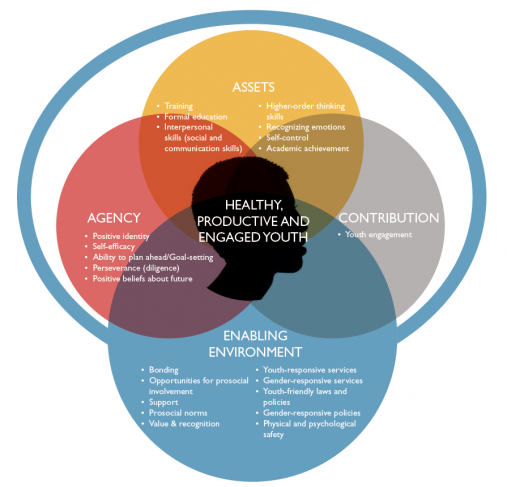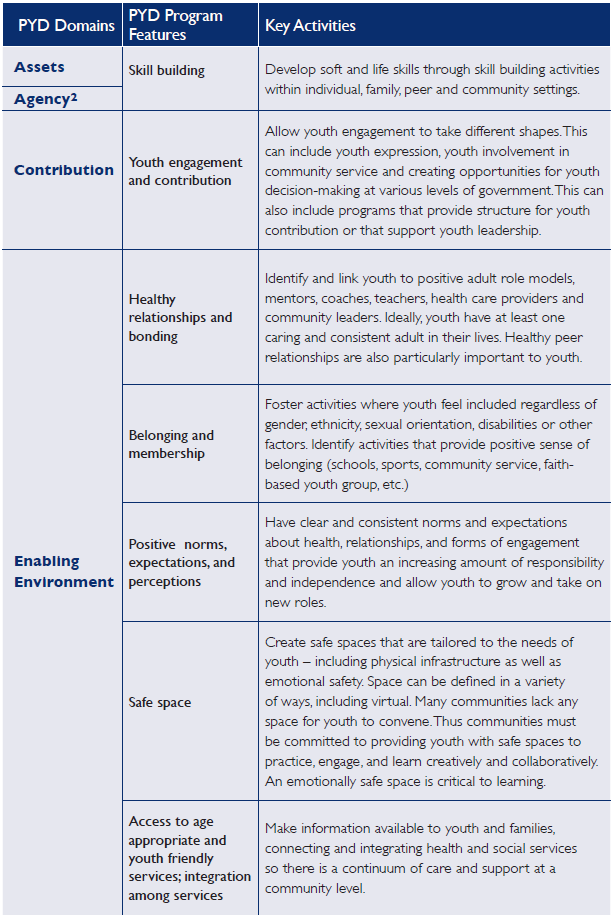Positive Youth Development (PYD) Framework
This framework for measuring PYD illustrates that to achieve the vision of healthy, productive and engaged youth, PYD programs, practices and policies must work with youth to improve their:

• Assets: Youth have the necessary resources, skills and competencies to achieve desired outcomes.
• Agency: Youth perceive and have the ability to employ their assets and aspirations to make or influence their own decisions about their lives and set their own goals, as well as to act upon those decisions in order to achieve desired outcomes.
• Contribution: Youth are engaged as a source of change for their own and for their communities’ positive development.
• Enabling environment: Youth are surrounded by an environment that develops and supports their assets, agency, access to services, and opportunities, and strengthens their ability to avoid risks and to stay safe, secure, and be protected and live without fear of violence or retribution. An enabling environment encourages and recognizes youth, while promoting their social and emotional competence to thrive. The term “environment” should be interpreted broadly and includes: social (e.g., relationships with peers and adults), normative (e.g., attitudes, norms and beliefs), structural (e.g., laws, policies, programs services, and systems) and physical (e.g., safe, supportive spaces).
PYD Framework with Program Features
Seven features of PYD are essential for strong for programs (See Table 3). These features link directly to the four domains presented in the PYD Framework. Like the domains, these features are grounded in the literature, particularly the work of the National Research Council and Institute of Medicine, but are tailored for the context of a developing country. The PYD features can help to define what activities can be incorporated within each of the four PYD domains.
Table 3: PYD Framework Domains and PYD Program Features

What does PYD mean for USAID and its Missions?
Both the PYD field and USAID’s Youth in Development Policy recognize youth participation as vital to development. Youths’ full participation in development efforts can contribute to more sustainable investments to end cycles of poverty; to build resilient, democratic societies; to improve health and nutrition outcomes; and to strengthen economies (Scales, Roehlkepartain & Fraher, 2012). USAID Missions can enact and reinforce the broader Agency’s efforts to empower youth by advancing programs which: 1) recognize that youth participation is essential for effective programming; 2) invest in youth’s assets; 3) foster healthy relationships by involving mentors, families and communities; 4) account for differences and commonalities among youth; 5) pursue gender equality; 6) harness youth innovation and technology; and 7) create second-chance opportunities for youth. Investments in youth translate to benefits for society by increasing youth’s connections to civil society and helping youth make successful transitions to adulthood (World Bank, 2007). The PYD approach can inform evidence-based design of future USAID youth-focused programing, and it can inform evaluation design for such programs.
What does PYD mean for implementers of USAID programming?
Programs that utilize a PYD approach have increasingly demonstrated that building the intellectual, physical, social, and emotional competence of youth is a more effective development strategy than one that focuses solely on correcting problems (Scales, Roehlkepartain, & Fraher, 2012). Incorporating a PYD approach during program design and using indicators of positive development to evaluate the program can help to assess trends in positive outcomes over the life of a project. When applied across multiple projects and sectors, implementers can ensure PYD program effectiveness within and across sectors, provide evidence for increased funding, and set the stage for program sustainability and scale-up. Implementers can incorporate and measure PYD in youth programming to improve program performance over time, contribute to the body of evidence on PYD, and ultimately influence multi-sector outcomes and impact.
Adapting PYD
Building the assets and skills of adolescents has potentially both immediate and long-term positive effects on the mental and physical health, economic development, and overall well-being of adolescents, their families and communities (Patton et al., 2016). However, while the adolescent experience has many shared elements globally, there are important variations in the needs and vulnerabilities of adolescents according to age, gender, and developmental stage, as well as cultural, socio-economic and environmental factors. It is therefore crucial that interventions take into account the distinct and diverse age-specific and context-specific needs of youth to create conditions in which youth can thrive (Patton et al., 2016). There is also tremendous variation from culture to culture about whether adolescence is formally recognized as a distinct stage of life, and progression toward adulthood is often dependent on cultural and historical contexts (Patton et al., 2016). This, in part, reflects the tremendous diversity of the youth experience globally, as well as in cultural and social conceptualizations of how transitions are made between adolescence and adulthood (Crocket & Silbereisen, 2000). As a result, few programmatic and policy approaches have effectively and comprehensively addressed the needs of all youth, and rarely reach the most marginalized, including very young youth, those living in extreme poverty, married youth, out-of-school youth, and others.
USAID seeks to strengthen and ensure the effectiveness of youth programming by moving investments from single-sector, problem-focused responses toward cross-sectoral PYD investments that help countries support youth in reaching their full potential. Building on the theoretical and empirical work on positive youth development and USAID’s Youth and Development Policy, YouthPower Learning developed a conceptual framework of positive youth development that is contextually relevant and provides a basis for the use of positive indicators across multiple sectors in LMICs. A targeted PYD approach will enable USAID to understand what components work best for specific segments of youth across sectors.







